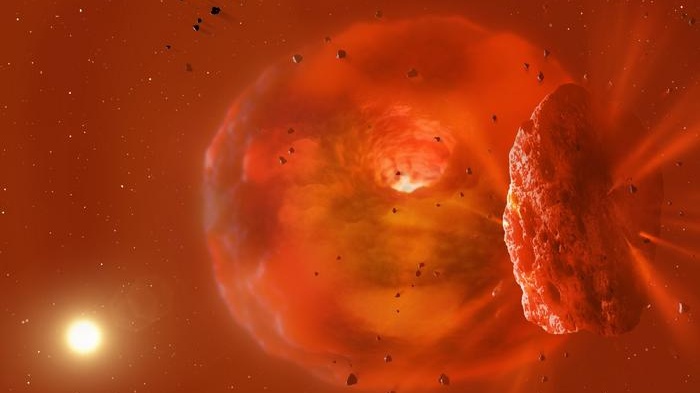1st evidence of giant exoplanet collision afterglow explains unusual eclipse
The findings could shed light on how solar systems evolve through chaotic and violent events.

On Wednesday (Oct. 11), an international team of astronomers reported the first-ever sightings of the aftermath of two giant planets colliding around a sun-like star in another planetary system. Such clashes among planets are not uncommon in our own solar system's history, so these latest findings shed light on how cosmic neighborhoods similar to our own evolve across eons through chaotic and violent events.
Astronomers first spotted the afterglow of the collision between two super-Earths — ice giants more massive than Earth but lighter than Neptune — in December of 2021 when the planetary system's host star, called 2MASS J08152329-3859234, suddenly dimmed.
Follow-up observations in visible light wavelengths revealed the dimming was due to some sort of eclipse that lasted about 500 days. This eclipse began 2.5 years after infrared observations indicate a brightening event occurred, suggesting that whatever was eclipsing the star and causing it to dim had an orbital period of at least 2.5 years.
"I knew then this was an unusual event," Matthew Kenworthy, an associate professor at Leiden University in the Netherlands and lead author of the new work, said in a statement.
Related: A giant moon collision may have given rise to Saturn's iconic rings, study suggests
Based on the temperature and size of the eclipsing material (gleaned from computer model data), the team also concluded that debris must have formed after the two giant planets collided. Then, three years after the collision, it's possible that the remnant material happened to line up in front of the star from our viewpoint, reducing its brightness in visible wavelengths and leading to what scientists perceived as a mysterious eclipse.
The star itself is an otherwise common object suspected to be roughly 300 million years old, which is a lot younger than our own 4.6 billion-year-old sun. Multiple large impacts were a common occurrence among all planets and moons early in our solar system's history. Previous research shows such collisions ceased about 3.9 billion years ago, making way for the relatively peaceful system we see today, although infrequent impacts still occur.
Breaking space news, the latest updates on rocket launches, skywatching events and more!
Findings from the latest study, however, suggest it is possible mature planets also collide. Future observations with NASA's mighty James Webb Space Telescope can observe how this dust cloud diffuses over the next few years, the researchers say.
"Ultimately, the mass of material around the remnant may condense to form a retinue of moons that will orbit around this new planet," Zoe Leinhardt, an associate professor of astrophysics at the University of Bristol and co-author of the new study, said in the same statement.
A paper on these findings was published on Oct. 11 in the journal Nature.

Sharmila Kuthunur is an independent space journalist based in Bengaluru, India. Her work has also appeared in Scientific American, Science, Astronomy and Live Science, among other publications. She holds a master's degree in journalism from Northeastern University in Boston.
